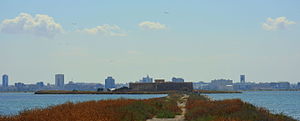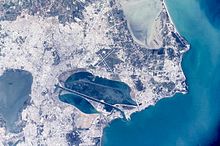Tunis
![]()
This article is about the capital of Tunisia; for other meanings see Tunis (disambiguation).
Tunis (Arabic تونس, DMG Tūnis, Central Atlas-Tamazight ⵜⵓⵏⵙ Tunes) is the capital of Tunisia and provincial capital of the governorate of the same name. It is the largest city in Tunisia and had a population of 1,056,247 in 2014, according to the census. The agglomeration is home to about two million inhabitants (June 2014). Its historic core, the Médina, is on the UNESCO World Heritage List.
After being a modest village in the shadow of Carthage, Kairouan and then Mahdia, the city was named capital on 20 September 1159 (5th Ramadan 554 of the Muslim calendar) under the Almohad government. Its status was subsequently confirmed by the Hafsids in 1228, and again after the country's independence from France on 20 March 1956.
Tunis is the economic and commercial capital of Tunisia. Its dense network of roads and highways and its relatively advanced air links make it a convergence point for national transport. This situation is a result of a long centralist policy, which has contributed to the fact that all important institutions are located in Tunis.
During the 20th century, the agglomeration has expanded outside the boundaries of the municipality. Currently, Tunis covers four governorates, Tunis, l'Ariana, Ben Arous and La Manouba, and is called Le Grand Tunis (the Great Tunis).
In 2017, Tunis was ranked 113th in the world ranking of most livable cities and 1st in North Africa.
Etymology
According to Paul Sebag, Tunis is the transcription of a name pronounced tûnus, tûnas, or tûnis (û has the value of a u in German) in the most common Tunisian dialects. The three terms were already mentioned by the Syrian geographer Yāqūt ar-Rūmī in his work Mu'jam al-Bûldan (Dictionary of Lands). The third predominates, even in the inhabitant term tûnisi or tûnusi (Tunisian).
Taking into account all the vocalic variations, the name of Tunis probably has the meaning of bivouac or night camp. The French term Tunisie was also derived from the name of Tunis. This name was created by French historians and geographers and has become established in almost all European languages. However, the term Tunes (in Tunisian as well as Arabic) refers to both the city and the country. Whether one is talking about Tunis or Tunisia depends on the context.
A more recent explanation says that the name is derived from the Berber term Tinast. It means key of fertility and refers to the fertility of the soil in the area. Another theory links the name to the Punic goddess Tanit and argues that several ancient cities were named after deities. A third theory links the name to the city of Tynes, mentioned by Diodorus and Polybios.

General view of Tunis
Geography
Location
Tunis is located in the north of the country not far from the Mediterranean Sea. Between the city and the Gulf of Tunis lies the Lake of Tunis, a shallow lagoon. Time: GMT+1h.
Districts and suburbs
The city centre of Tunis with the historic old town (medina) and the new town built during the colonial period is located between the Lake of Tunis and the Lake Sebkhet Sedjoumi (Arabic سبخة سيجومي).
Surrounding the city centre are the inner suburbs: to the west, the villa and government district of Le Bardo with the museum of the same name; to the north, the district around the Belvédère hills and the newer settlements of El Menzah and Ariana; to the south, the industrial districts of Megrine and Ben Arous.
During the colonial period, the French built a 10 km expressway and light rail embankment across the Lake of Tunis as a continuation of Avenue Habib Bourguiba, linking downtown Tunis with the port city of La Goulette (Halk al-Wadi). To the north of La Goulette, the prosperous suburbs of Qartāj (Carthage, Karthago) with Tunis International Airport, Sidi Bou Saïd, La Marsa and Gammarth line the coast; to the southeast lies the seaside resort of Hammam-Lif.
Climate
Tunis is located in the subtropical climate zone and within the range of winter-humid-summer-dry Mediterranean climate in the north of Tunisia. The annual mean temperature is 17.7 °C, the annual precipitation total is 465 mm. The majority of this precipitation falls in the winter half of the year, while an arid climate prevails in the summer. The hottest and driest months are July and August with monthly average temperatures around 26 °C. In January and February the monthly average is just above 10 °C.
| Tunis-Carthage | ||||||||||||||||||||||||||||||||||||||||||||||||
| Climate diagram | ||||||||||||||||||||||||||||||||||||||||||||||||
| ||||||||||||||||||||||||||||||||||||||||||||||||
| Monthly average temperatures and precipitation for Tunis-Carthago
Source: WMO 1976 - 2005 and National Institute of Meteorology Tunisia; water temperature and humidity: wetterkontor.de. | ||||||||||||||||||||||||||||||||||||||||||||||||||||||||||||||||||||||||||||||||||||||||||||||||||||||||||||||||||||||||||||||||||||||||||||||||||||||||||||||||||||||||||||||||||||||||||||||||||||||||||||||||||||||||||||||||||||||||||||||||||||||||||||||||||||||||||||||||||||||||||

Satellite image of Tunis and surroundings
Search within the encyclopedia